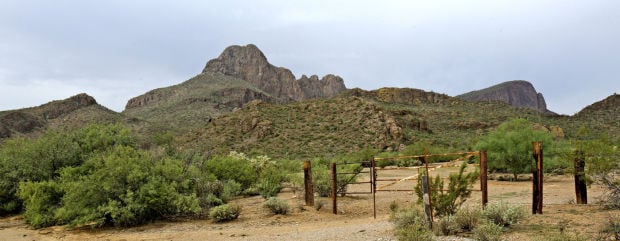Nature lovers, ecology experts and other concerned citizens offered pleas, marked-up maps, family photo albums and even some tears Wednesday night during an emotional public hearing on the future of the Lazy K Bar Guest Ranch.
Despite opposition from the public, Marana’s planning commission voted for the third time since 2014 to recommend Town Council approval for a plan to turn the historic dude ranch into a 178-home subdivision.
Eighteen members of the public spoke out during the hearing about the plan to rezone the Lazy K ranch, but not one voiced support for it.
Commissioner Marcia Jakab said their testimonies changed her vote to a “nay.”
“I’ve sat in this position for almost 10 years,” she said before the roll-call vote, which went 4-1 in favor of approval. “And even when we had meetings that were approaching midnight about the landfill (a heated Marana rezoning debate in 2010), there was always somebody that came forward that was supporting it. And there was absolutely no support in this audience tonight.”
But the project developer said she was encouraged there appeared to be fewer opponents in the audience Wednesday night than in the past.
“I didn’t take it as a united front against it,” Linda Morales, CEO of The Planning Center, said Thursday. The Tucson design firm, in partnership with developer Greg Wexler, is crafting the Lazy K plan on behalf of the property owners. “I felt like it was a better position than we’ve been in the past two times.”
The proposal would rezone the ranch site to allow for a subdivision with four times the density allowed under current zoning, which permits about 42 homes — one per 3.3 acres — or a 600-unit hotel. The new “specific plan” zoning would allow for about 1.3 homes per acre, with lot sizes ranging from 6,000 to 11,200 square feet.
“The lot sizes we’re proposing are absolutely something homebuilders are interested in and buyers are interested in,” Morales said. “The acre-plus lots are not necessarily selling on the market right now.”
The latest version of the Lazy K proposal includes at least 60 percent open space, a hiking trail and preserves the original stone homestead and the existing outdoor fireplace, patio and event lawn as a common area. The homes could cost up to $600,000.
On May 16, the development and rezoning proposal is scheduled to go before the Town Council, which has already rejected the proposal twice.
But for both of those earlier votes, the rezoning plan needed support from a supermajority of council members — six of seven members — in order to pass. Under state statute, a supermajority is required for zoning changes that are opposed by 20 percent of adjacent property owners.
This time, developers found a way to avoid triggering that requirement. The supermajority requirement doesn’t apply if the opposition comes from neighbors who are more than 150 feet away from the land being rezoned. So this year, developers added a 150-foot strip of land around the perimeter of the Lazy K property that won’t be rezoned. Now the proposal can pass with a simple majority, or four “yes” votes, and only 103 acres of the 138-acre property will be rezoned.
Morales defended the decision to add the 150-foot buffer.
“The developer was willing to give up 35 acres of the site as natural open space to buffer the property and to take it out of the protest area,” Morales told the commission. “That 150-foot (condition) was put in by state law because it was deemed to be the area most affected” by a zoning change.
Local historian Ken Scoville, who opposes the development plan, said the move steamrolls an important check on controversial government actions. The 150-foot buffer does not change the level of opposition to the project, or its impact, he said on Thursday.
“We’re going to circumvent our representative government and the checks put in place, just so we can appease the developer and get the project through,” he said. “It’s just wrong.”
WILDLIFE CORRIDOR SHRINKING
Speaker after speaker told the commission that 178 homes do not belong in the environmentally fragile site. Opponents also said the development disrupts what little remains of a crucial wildlife corridor between the Tucson Mountains and the Tortolitas, despite developers’ efforts to minimize the project’s impact on the crossing.
Much of the original one-mile wide wildlife corridor — established by Pima County’s Sonoran Desert Conservation Plan — is already occupied by high-density housing east of Scenic Drive, said Barbara Rose, a vocal opponent of the Lazy K proposal. Pima County’s conservation plan had protected the Lazy K property until it was annexed into Marana in 2001. Marana’s own draft habitat conservation plan was never formally adopted.
Lazy K property owners Jim Shiner and Peter Evans have been trying since 2014 to get a plan approved to finally develop their land. The site is a half-mile north of Saguaro National Park West, and is west of North Silverbell Road and south of West Twin Peaks Road.
Opponents are also concerned about increased traffic in the area and the impact of reopening Scenic Drive, which runs along the eastern edge of Lazy K, where walkers, cyclists and wildlife are common.
The commission’s recommendation included the condition that a covenant be enacted to ensure the open space established in the site plan will be enforced by a third-party, such as the Arizona Land and Water Trust.
Before casting her “yea” vote, commissioner Terry Fehrmann said, “In review of this plan, I will tell you it’s greatly improved” from two years ago. She called the plan “acceptable,” noting the developers have made many compromises, including keeping all homes single-story.
Scoville said the apparent lack of enthusiasm about the subdivision plan is telling.
“Everybody’s like, ‘Well, it could be worse,’” he said. “Is that the way you develop a city?”





